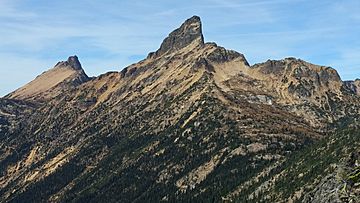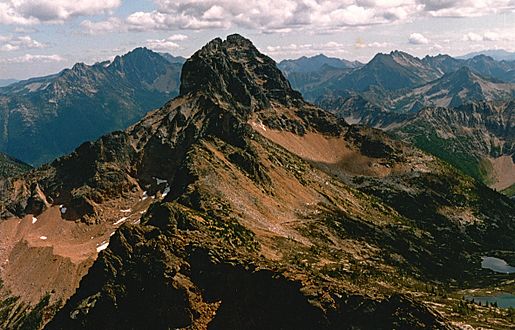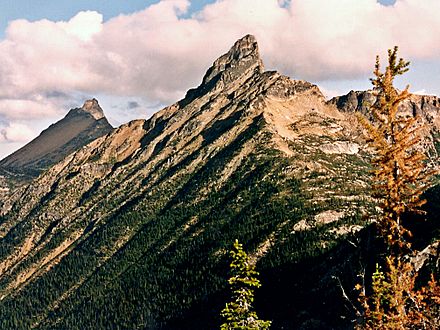Tower Mountain (Washington) facts for kids
Quick facts for kids Tower Mountain |
|
|---|---|

Tower Mountain seen from Pacific Crest Trail
|
|
| Highest point | |
| Elevation | 8,444 ft (2,574 m) |
| Prominence | 2,884 ft (879 m) |
| Geography | |
| Parent range | North Cascades |
| Climbing | |
| First ascent | 1913 |
| Easiest route | Climb, class 3 |
Tower Mountain is a tall mountain in Washington state. It stands out because it's not a volcano. You can find it right on the border between Okanogan and Skagit counties.
This mountain is part of the Okanagan Range, which is a smaller group of mountains within the larger North Cascades Range. Tower Mountain is located on land managed by the Okanogan National Forest.
Mountain Weather
Tower Mountain is in a part of western North America that has a wet and mild climate. This means it gets a lot of rain and snow. Most of the weather comes from the Pacific Ocean.
These weather systems travel northeast towards the Cascade Mountains. When they reach the tall peaks of the North Cascades, the air is forced to rise. As the air goes up, it cools down and drops its moisture. This causes a lot of rain or snowfall to fall on the mountains. This process is called Orographic lift.
Because of this, the western side of the North Cascades gets a lot of precipitation. This is especially true during winter, when most of it falls as snow. In winter, the weather is usually cloudy. But in summer, high pressure systems over the Pacific Ocean often bring clear skies.
The snow here tends to be wet and heavy because of the ocean's influence. This can make the risk of avalanches higher, so it's important to be careful.
How Tower Mountain Was Formed
The North Cascades are known for their very rugged landscape. They have sharp, rocky peaks, long ridges, and deep valleys carved by glaciers. These features were created by geological events that happened millions of years ago.
These events caused big changes in the land's shape and height. These changes also led to different climates in various areas. These climate differences then created different types of plant life, defining the ecoregions here.
The Cascade Mountains began forming millions of years ago, during a time called the late Eocene Epoch. The North American Plate was slowly moving over the Pacific Plate. This movement caused many periods of volcanic activity. Also, small pieces of the Earth's crust, called terranes, joined together to form the North Cascades about 50 million years ago.
Later, during the Pleistocene period, which was over two million years ago, glaciers grew and shrank many times. As they moved, these huge sheets of ice scraped and shaped the land. They left behind piles of rock and debris. The "U"-shaped valleys you see today were carved out by these glaciers.
The main forces that created the tall peaks and deep valleys of the North Cascades were the land being pushed up (orogeny) and broken along cracks (faulting), along with the powerful action of glaciers.
Gallery
-
Tower Mountain (centered) and Golden Horn (left)




